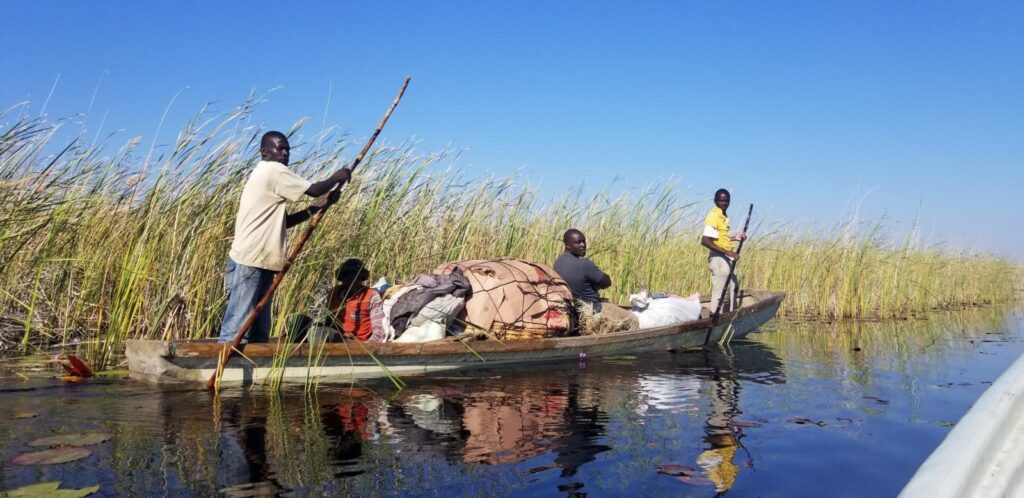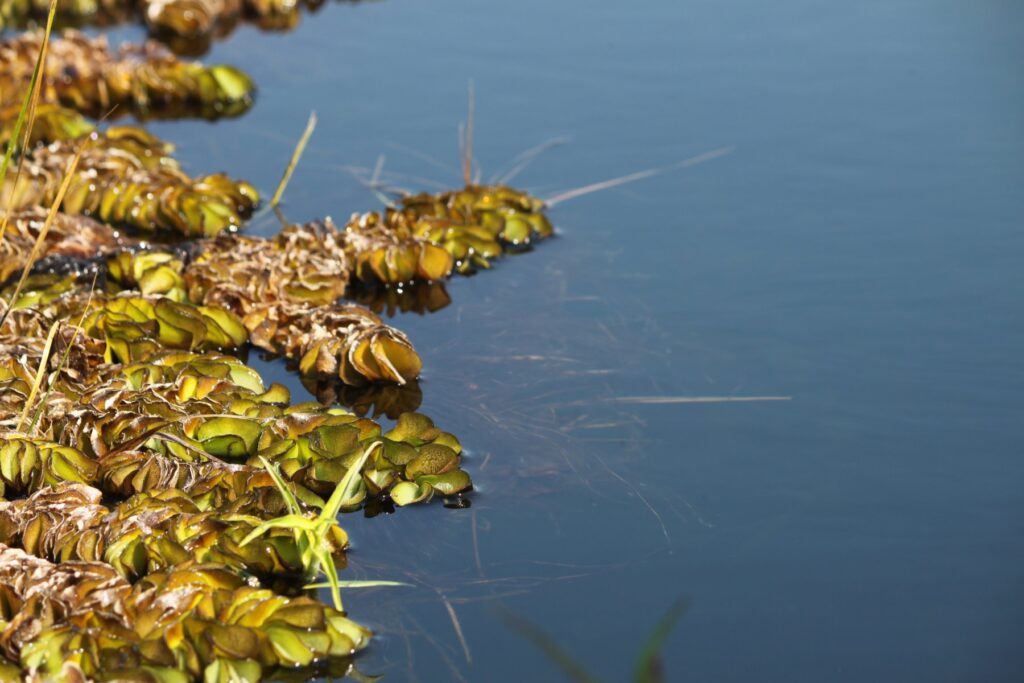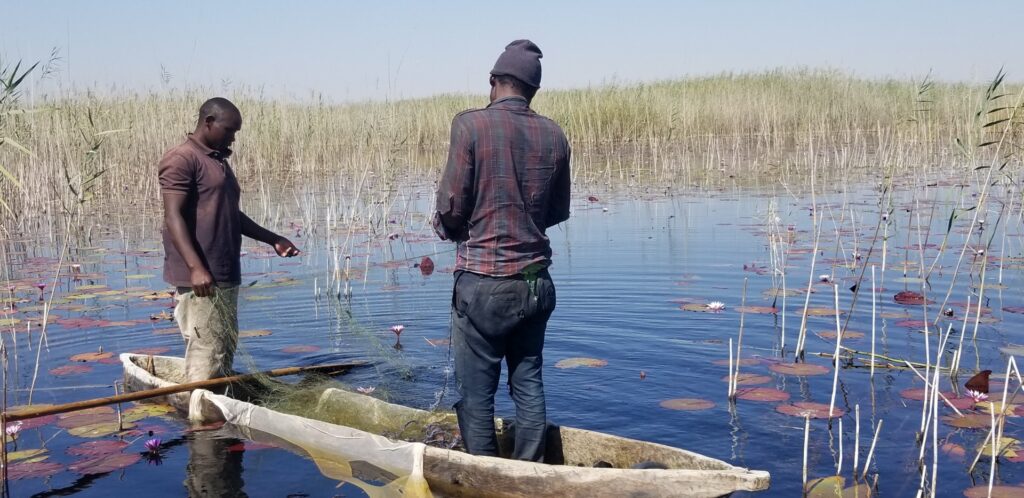Restoring the Lukanga: Tackling Invasive Weed Species in Zambia

By Chaona Phiri, Clara Nanja & Lewis Kihumba
Cover photo: Active water transport in some recently cleared canals © Clara Nanja
In two decades of fishing, Boyd Kayombo has witnessed a steady decline in his catch. Kayombo sighs as he tugs at his nets. “The fish catch is poorer and the water has turned pale and green”, he remarks wiping sweat from his brow on a hot fishing day.
Kayombo is part of the fishing community living around the Lukanga Swamp, one of Zambia’s eight major wetlands and a Ramsar site. Lukanga Swamp is located in Central Zambia about 55km west from the town of Kabwe. The site is an Important Bird and Biodiversity Area (IBA) covering approximately 3300 km², and hosts over 350 residents and migratory bird species including some globally threatened species such the Wattled Crane Bugeranus carunculatus, African Skimmer Rynchops flavirostris, and African Finfoot Podica senegalensis.
Lukanga Swamp is also home to a variety of other species including semi-aquatic antelopes such as Sitatunga, (Tragelaphus spekei), Oribi (Ourebia ourebi), and Red Lechwe (Kobus leche leche). Reptiles such as the Nile crocodile, (Crocodylus niloticus), African Rock Python (Python sebae), and Monitor Lizard species are also common in isolated portions of the swamp. Fishing is a major economic activity in the swamp, hosting a fishing community of approximately 22,500 and contributing at least 10% of Zambia’s national fish supply.
Over the years, Zambia’s wetlands have increasingly come under threat from land use change, poor land management, damming, mining and encroachment. Additionally, invasive species – species that are not native to a specific location and spread extensively damaging ecosystems, are having a toll on the country’s wetlands. Invasive species establish breeding populations, and thrive fast, and in the absence of natural predators, these species thrive and successfully colonize ecosystems. Human activities is the most common ways through which invasive species including plants and animals colonize new habitats.

The invasive Kariba Weed (Salvinia molesta) has infested the Lukanga swamp ecosystem since 2009. Over the years, the invasive weed has grown to cover an approximate area of 2000 km² – more than 50% of the swamp’s surface area. Additionally, the weed has reduced the amount of fish caught in the swamp, and the quality of habitat. Kariba weed forms a mat on the water, reducing sunlight and oxygen, ultimately leading to death of fish. This has led to the use of inappropriate fishing methods like mosquito nets and poison in bid to catch more fish.
Since 2013, BirdWatch Zambia (BirdLife Partner) has been involved in controlling the weed. Initially, this was done manually where community members used sickles, rakes and pitchforks to remove the weed. However, this method proved unsuccessful due to its spread, with spores quickly dispersing and germinating leading to regrowth of the weed.
In 2017, BirdWatch Zambia, through BirdLife International secured funding from the UK Government’s Darwin Initiative for a multi-year project to control the invasive weed naturally.
Depending on climate and extent of the weevil’s infestation, weed mats sink within one to three years.
After a successful importation of the weevils, most of them were introduced in various Salvinia infested points in the swamp, while a few were retained for mass rearing, prior for further introduction at more points within the swamp. Since October 2018, when they were first introduced into the swamp, the weevils have spread to over 650km² resulting in clearing some canals, thereby enabling fishing and swimming activities in the cleared areas.

“I heard there is a weevil that BirdWatch Zambia introduced in the Lukanga to feed on this weed, and have seen it before. It is small but powerful. Some canals are clear and easier to navigate through now”, says Patrick Ndemena a local fisherman.
“I decided to attended one of the community meetings were they explained how the weevil works, because I was worried that it could harm both the fishermen and the fish. I had a lot of questions! They explained everything. The weevil has not harmed any fish or swamp plants, it is a good weevil, it minds its business.”, he notes with a laugh.
“There is hope for restoration of the Lukanga”, he adds with a wide smile on his face.
“It is such a delight to see the Lukanga habitat improve from when I first saw it in 2017”, notes Clara Nanja, BirdWatch Zambia’s wetlands project officer. “The unfolding success story of the Lukanga, serves as an example of a well implemented biological control project. The weevils have proven their resilient, self-sustaining and highly adaptive behaviour in the Lukanga, at present covering an area of about 662 km² , based on recent weevil monitoring surveys.
This project is being conducted in partnership with the Ministry of Livestock and Fisheries, Zambia Agriculture Research Institute (ZARI), Zambia Environmental Management Agency (ZEMA) and Centre for Agriculture and Bioscience International (CABI) and the Local Site Support group.
“I am leading an enthusiastic and hardworking team that is working to see the project outcome achieved and ultimately creating a good habitat that benefits both swamp biodiversity and the local community. Once the weed is controlled, it is expected that there will be improved fish catch, restored habitat and an increase in the population of the globally threatened species and other water birds, thus benefitting biodiversity and improving the livelihoods of more than 2500 fishermen by the end of the project in 2021”, concludes Clara.


